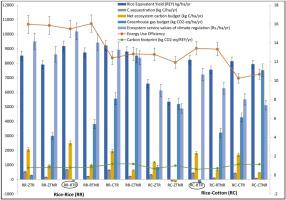Soil and Tillage Research ( IF 6.5 ) Pub Date : 2021-05-23 , DOI: 10.1016/j.still.2021.105076 Uttam Kumar Mandal , A.K. Bhardwaj , T.D. Lama , Dibyendu Bikas Nayak , Arpan Samui , D. Burman , K.K. Mahanta , Sukanta K. Sarangi , Subhasis Mandal , S. Raut

|
Rice (Oryza sativa) based cropping in the Asian region is considered as one of the most significant agricultural practices that contribute to climate change due to high energy use and carbon footprints (CF). To assess the contributions of rice-based cropping in lowland coastal ecosystems to environmental change, energy budgets, CF, exchange of CO2 and fluxes of non-CO2 greenhouse gases (GHGs) were determined for an array of conservation tillage practices under rice-rice (RR) and rice-cotton (Gossypium hirsutum) (RC) systems as main plot treatments, tillage intensity [zero tillage (ZT), reduced tillage (RT), conventional tillage (CT)] as sub-plot treatments, and residue (R) or no residue (NR) as sub-sub plot treatments. The energy use was calculated operation-wise and RT was recorded to be most efficient in terms of energy utilization. Rice-based cropping system enhanced soil organic carbon (SOC) at the rate of 0.22 to 0.69, and 0.09 to 0.45 Mg ha−1yr−1 in rice-rice and rice-cotton systems, respectively, with the exception of RC-ZTNR which depleted SOC by 0.11 Mg ha−1yr−1. Static chamber-gas chromatography-based methodology along with biometric data collection was used for the carbon and GHG budgeting. The evaluation of net ecosystem carbon budget (NECB, based on net ecosystem exchange of CO2 and non-CO2 carbon via crop harvest, CH4-C, C inputs to soils and C loss through runoff), and GHG budget (GHGB, adding CH4 and N2O fluxes, and emissions from inputs used to the NECB on CO2 equivalent basis) showed that the rice-based cropping systems in lowland coastal ecologies functioned as carbon sinks (NECB:1523 and 944 Kg C ha−1yr−1 in rice-rice and rice-cotton system, respectively) but GHG source except under reduced tillage with residue (RTR) management which was a GHG sink (−68 to −228 Kg CO2-eq ha−1yr−1). The treatment RTR also recorded the least CF, and highest ecosystem service values of climate regulation among all tillage practices.
中文翻译:

沿海低地双季稻生态系统中碳,温室气体和能源收支的净生态系统交换
在亚洲地区,稻谷(Oryza sativa)种植被认为是最重要的农业实践之一,由于高能耗和碳足迹(CF)导致气候变化。为了评估低地沿海生态系统中以水稻为基础的作物对环境变化的贡献,确定了能源预算,CF,CO 2交换和非CO 2温室气体通量(GHGs),以用于水稻保护下的一系列耕作实践。水稻(RR)和水稻棉(陆地棉))(RC)系统作为主要地块处理,耕作强度[零耕种(ZT),减耕(RT),常规耕种(CT)]作为子地块处理,并且残留物(R)或无残留物(NR)作为子地块处理-子情节治疗。能源使用是按操作计算的,并且记录的RT在能源利用方面是最有效的。除RC-ZTNR以外,水稻种植系统在水稻-水稻和水稻-棉花系统中分别以0.22至0.69和0.09至0.45 Mg ha -1 yr -1的速率提高土壤有机碳(SOC)SOC减少了0.11 Mg ha -1 yr -1。基于静态室气相色谱的方法以及生物特征数据收集被用于碳和温室气体的预算编制。评估生态系统净碳预算(NECB,基于通过作物收获,CH 4 -C,土壤碳输入和径流碳损失的CO 2和非CO 2碳的生态系统净交换)和温室气体预算(GHGB,添加CH 4和N 2 O通量,以及NECB投入的CO 2当量产生的排放量)表明,低地沿海生态系统中的稻谷种植系统起到了碳汇的作用(NECB:1523和944 Kg C ha -1) yr -1分别在水稻-稻米和棉花/棉花系统中),但温室气体源除外,这是通过减少耕作残留物(RTR)进行管理的,其为温室气体汇(-68至-228 Kg CO 2 -eq ha -1 yr -1)。在所有耕作方法中,RTR的处理还记录了最低的CF和最高的气候调节生态系统服务价值。



























 京公网安备 11010802027423号
京公网安备 11010802027423号